Kaiwhaiki

Kaiwhaiki is a settlement 18 kilometres (11 mi) upriver from Whanganui, New Zealand.
Kaiwhaiki in the 1840s was a small pā of a few dozen people, members of the hapū Ngāti Rongomaitawhiri.[1] In 1852 it became the first settlement on the Whanganui River to host a Catholic mission.[2] By the early 1860s, its population were mostly Kingites, opposed to the colonial government.[1]
Kaiwhaiki is now home to the Ngāti Tuera hapū of the iwi Te Āti Haunui-a-Pāpārangi.[2] Their unique twin-gabled wharenui Te Kiritahi was built in 1912.[3][4] Kaiwhaiki was the birthplace of composer and choirmaster Morvin Simon, who led the nationally-known Kawhaiki-based kapa haka group Te Matapihi.
A quarry near Kaiwhaiki supplied the shellrock used to build the Durie Hill war memorial tower in Whanganui.[2]
References
- 1 2 Walton, A. (1994). "Settlement Patterns in the Whanganui River Valley, 1839–1864" (PDF). New Zealand Journal of Archaeology 16: 123–168.
- 1 2 3 Beaglehole, Diana (20 March 2014). "Whanganui places: River Settlements". Te Ara Encyclopedia of New Zealand. Retrieved 21 November 2015.
- ↑ "Kaiwhaiki Pā". Māori Maps. Retrieved 23 November 2015.
- ↑ "History of Kaiwhaiki Marae published". Radio New Zealand News. 11 December 2012. Retrieved 22 November 2015.
| ||||||||||||||||||||||||||